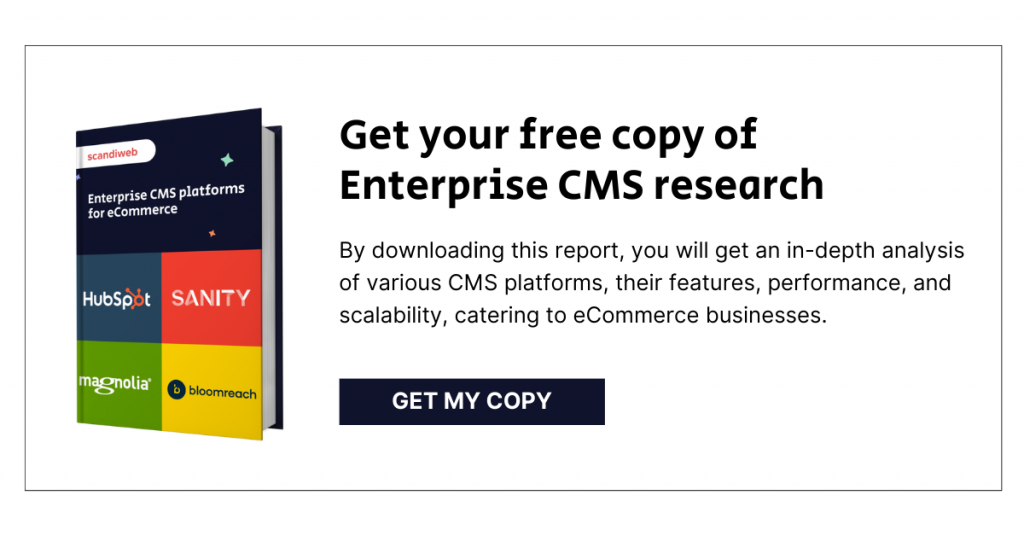The post Hiring an eCommerce Agency: A Comprehensive Guide (2024) appeared first on scandiweb.
]]>As the eCommerce sector continues to exhibit remarkable growth, driven by evolving consumer behaviors and technological advancements, having an eCommerce agency partner is critical to your online success.
Hiring an eCommerce agency that can effectively leverage advanced technologies and strategic insights is vital for enhancing your competitive edge and driving sustainable business expansion. This guide lays down the steps you need to take and considerations you must keep in mind to hire the eCommerce agency that best aligns with your business needs and goals.
Identifying your eCommerce needs
Before partnering with an eCommerce agency, it’s crucial to clearly understand your business goals and the specific challenges you face online.
Start by assessing your current digital presence—analyze your website’s design, user experience, conversion rates, and backend functionalities. Identify areas that require enhancement, such as mobile optimization, personalized customer experiences, or integrated marketing strategies.
Agencies like scandiweb specialize in addressing these complex needs by offering customized solutions that leverage advanced technologies and data-driven insights. Our experience spans designing visually appealing and highly functional eCommerce sites to deploying complex backend solutions that streamline operations and enhance user engagement.
Types of eCommerce agencies
Selecting the right eCommerce agency involves understanding the different types of agencies available and recognizing which is best suited to meet your business needs. Here are three common types of eCommerce agencies.
Full-service eCommerce agencies
Full-service agencies provide a comprehensive range of services covering all aspects of eCommerce. These include website design and development, marketing (SEO, PPC, social media, email), analytics, and customer service solutions, and sometimes extend to logistics and post-purchase support. They are ideal for companies looking for a one-stop solution that can handle multiple facets of their eCommerce operations.
Key benefits
- Ensures all elements of eCommerce—from technical development to marketing—are aligned and managed cohesively
- Reduces the need to coordinate with multiple vendors or internal teams
Specialized eCommerce agencies
Specialized agencies focus on specific aspects of eCommerce, such as SEO, paid advertising, or platform-specific development (e.g., Magento, Shopify). They possess deep expertise in their focus areas and can provide advanced insights and solutions.
Key benefits
- Offers in-depth knowledge and skills in specific areas, which can lead to more effective and innovative solutions
- Services are highly customized to specific challenges or goals
Boutique agencies
Boutique agencies offer digital marketing and eCommerce development services on a smaller scale. They often cater to niche markets or smaller businesses, prioritizing personalized service and close client relationships.
Key benefits
- Smaller size allows for more adaptability and customized approaches to projects
- Particularly effective for unique or specialized market segments that may not be the primary focus of larger agencies
Also read:
8 Reasons to Change Your eCommerce Agency
Reimagining Your eCommerce Store with Apple Vision Pro
How to find the right eCommerce agency for you
Selecting the right eCommerce agency involves more than just scanning through portfolios.
Consider factors such as the agency’s expertise in the specific technologies you use, their experience with businesses in your industry, and their ability to scale solutions as your business grows.
Agencies that offer a broad spectrum of services, from Magento development to performance marketing and custom software solutions, might be particularly advantageous.
Here’s a step-by-step guide on how to find and hire the right eCommerce agency for your business
1. Assess technology expertise
Start by identifying agencies with a strong track record with the eCommerce platforms and technologies your business uses, such as Magento/Adobe Commerce, Shopify, BigCommerce, or custom software solutions.
Agencies with specific technical skills can better tailor their services to fit your platform’s unique needs, ensuring more efficient and practical implementations.
Verify their technical certifications and awards, which reflect their competence and commitment to quality in these areas. Ask for case studies or examples of how they have successfully integrated these technologies for other clients.
2. Evaluate industry experience
Look for agencies that have extensive experience working with businesses in your industry. This experience means they are likely familiar with the common challenges and trends in your market, allowing them to provide relevant and proactive insights and solutions.
3. Check for scalability
Ensure the agency can scale its services as your business grows.
An agency capable of scaling effectively will not only be able to handle the increased workload but also adapt to evolving digital trends and business requirements.
Inquire about different client scenarios where they have managed scaling and how they adjust their staffing, resources, and strategies in response. It’s essential that they can demonstrate flexibility in services and pricing to accommodate your growing business needs.
4. Review past projects and testimonials
Analyzing the agency’s portfolio will give you insight into the breadth and depth of its capabilities. Client testimonials can provide a glimpse into the agency’s reliability and the satisfaction level of past clients.
Look for detailed case studies that showcase the agency’s problem-solving skills and the tangible results they’ve delivered. Ensure these projects reflect various challenges and solutions, indicating the agency’s ability to handle diverse requirements.
7. Book a discovery call
Schedule a discovery call with potential agencies to discuss your needs and goals. This step is critical as it lets you get a feel for their approach, expertise, and the chemistry between your teams.
6. Look for transparency in communication
Effective communication is crucial for the success of any project. Determine if the agency practices transparency in its processes and communications, which is essential for trust and long-term relationships.
Note how they explain complex concepts and whether their communication style aligns with your company’s internal culture. During initial discussions, observe if they listen as well as they speak, which suggests a collaborative approach.
7. Align on business objectives
The right agency should clearly understand your business objectives and demonstrate how their strategies will help achieve them. They should be proactive in suggesting innovative solutions that align with your business vision.
Discuss how they measure the impact of their efforts and evaluate success in previous projects. Alignment on business objectives ensures that the agency will act as a true partner in your growth rather than just a service provider.
What to expect in a discovery call?
Purpose of the call
Arrange a discovery call to engage directly with the agency, allowing you to present your business needs, challenges, and goals. This initial conversation is crucial for assessing whether the agency’s approach aligns with your expectations and requirements.
Before the call
Prepare a list of questions that cover essential topics such as their approach to project management, examples of similar projects they have handled, and their strategy for dealing with potential challenges. This preparation ensures that you cover all critical areas and gather necessary information.
Evaluating communication style
Use the discovery call to evaluate the agency’s communication style. Notice how they describe their processes, how well they understand your queries, and their ability to articulate clear, strategic responses. Effective communication during this call is a strong indicator of future interactions.
Discussing collaboration expectations
Discuss how they handle collaboration with clients, including tools, frequency of updates, and involvement levels. This is also the time to talk about their flexibility regarding project adjustments and scaling operations to meet your growing business needs.

scandiweb is a full-service eCommerce agency
scandiweb is a full-service eCommerce agency offering a comprehensive suite of services from web development and performance optimization to advanced marketing strategies and customer experience improvements.
Unlike typical agencies that may spread their knowledge and skills too thinly over various disciplines, scandiweb ensures deep expertise in specific domains such as Magento development, Progressive Web Apps (PWA), SEO, PPC, and comprehensive digital marketing strategies. This specialization within a full-service framework allows us to offer advanced insights and highly customized solutions, ensuring that every aspect of eCommerce, from technical development to marketing and customer experience, is handled expertly and cohesively.
With a strong focus on data-driven results and a robust portfolio featuring projects across various industries, scandiweb provides a one-stop solution for businesses looking to expand and refine their online presence.
scandiweb’s core offerings are in the following areas:
- Strategy
- Technology
- Customer Experience
- Acquisition & Retention
- Data & analytics
Among other eCommerce platforms, scandiweb specializes in:
- Magento / Adobe Commerce
- Shopify
- BigCommerce
- commercetools
- Salesforce Commerce Cloud
Official partnerships
- Most Certified Adobe Commerce Agency
- Pimcore Gold Partner
- Hyvä Gold Partner
- OroCommerce Silver Partner
- Dotdigital Silver Partner
- BigCommerce Agency Partner
- Klevu Solution Integrator Partner
- More partners
Wrapping up
Remember that hiring an eCommerce agency to work with is as much about forging a partnership as it is about procuring a service.
Your selected agency should not only have the expertise in the technologies you already use or are interested in but also must align closely with your business vision and goals. This alignment and their ability to scale solutions and communicate transparently will set the foundation for sustained digital growth and innovation.
Ready to start the conversation about the future of your eCommerce business? Use the form below to book a discovery call with our eCommerce experts.
The post Hiring an eCommerce Agency: A Comprehensive Guide (2024) appeared first on scandiweb.
]]>The post Magento for eCommerce Growth: Custom Solutions for the Apparel & Fashion Industry appeared first on scandiweb.
]]>Our journey with leading brands in the Apparel & Fashion industry has been about turning challenges into opportunities for growth and innovation through Magento development and strategic implementation of custom features. This collection of case studies is a sample of our experiences and solutions across various projects to highlight our tailored approach to enhancing online retail platforms.
The challenge
The Apparel & Fashion industry encounters several eCommerce challenges that can stifle growth if not addressed effectively.
- Many clients struggle with platforms that cannot handle high traffic volumes or maintain performance during peak sales periods.
- Ensuring a seamless and consistent shopping experience across various devices and touchpoints is often problematic, especially for brands with a global presence.
- Integrating with existing systems such as inventory, customer relationship management (CRM), and other third-party services while maintaining operational efficiency poses a significant challenge.
- Translating a brand’s physical presence into the digital world effectively without losing its essence and appeal requires sophisticated customization and design capabilities.
- Brands looking to expand internationally face hurdles with multi-language and multi-currency configurations, as well as localization issues.
Our approach
scandiweb’s approach to tackling these challenges involves a combination of strategic planning, advanced technological implementation, and continuous support. We leverage Magento’s flexibility to create custom solutions tailored to each brand’s specific needs.
Focus on scalability
Our solutions are designed with scalability in mind, allowing brands to grow their online presence seamlessly with their business. We ensure that platforms can handle increased traffic and transactions without compromising performance.
Enhancing user experience
By employing the latest in UX/UI design trends and technologies, we create engaging and intuitive shopping experiences that reflect the brand’s identity and meet the high expectations of fashion consumers.
Integration with 3rd-party solutions
We ensure robust integration of Magento with existing ERP, CRM, and other essential systems to streamline operations and improve efficiency. This also includes integrating advanced marketing tools to enhance customer engagement and retention.
Global expansion support
Our approach includes setting up multi-language and multi-currency features, localizing content, and complying with regional regulations to support international market expansions.
Case Study 1: Enhancing global reach for BUFF® through Adobe Commerce
For BUFF, a leader in multifunctional headwear and accessories tailored for active lifestyles, upgrading their eCommerce infrastructure was essential to manage increasing international demands and enhance the overall customer experience.
The objective was to enhance platform scalability and optimize the user experience to increase international sales and customer satisfaction.
- Transition from Magento Open Source to Adobe Commerce
- Leveraging Adobe Commerce’s features to implement custom solutions that manage complex product attributes and facilitate scalability
- Implementation of multi-language and multi-currency capabilities
- Optimized navigation and checkout processes to enhance mobile conversions and user engagement
We developed multi-language and multi-currency capabilities for BUFF’s eCommerce platform to cater to its growing international audience, significantly improving accessibility and usability across diverse markets. This enhancement in internationalization features allowed BUFF to connect more effectively with customers worldwide, fostering a smoother and more inclusive shopping experience.
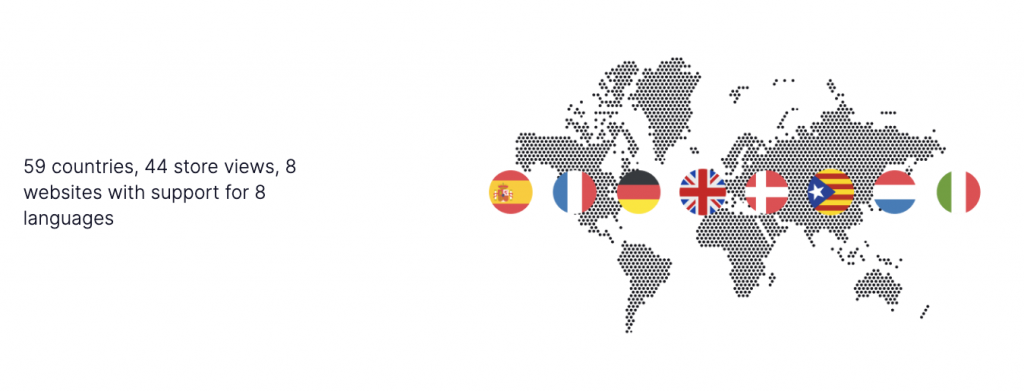
The move to Adobe Commerce on cloud infrastructure stabilized the platform under high traffic conditions and introduced operational efficiencies that previously were not possible.
The transformation resulted in a robust, scalable platform that supports BUFF’s growth and expands its global reach, enhancing user satisfaction and significantly boosting international sales.
Case Study 2: PWA, custom Magento features, and augmented reality for Sportland
By prioritizing the advancement of Sportland’s eCommerce infrastructure, the industry leader in sporting apparel and equipment aimed to seamlessly replicate its award-winning retail experience across all channels, demonstrating a strong commitment to a holistic customer journey.
- Tailoring the Magento platform to Sportland’s specific needs, enhancing both the frontend user experience and backend operations
- ScandiPWA frontend for a faster, smoother user interface that loaded instantly both on mobile devices and desktop
- AR integration for enhanced engagement
- Creating a cohesive flow between online and physical stores, ensuring that promotions and product availability were synchronized across all channels
- Infrastructure upgrade to handle increased traffic during high-demand periods
We implemented AR features that gave customers a 360-degree virtual view of products, significantly enriching the online shopping experience.
We also tailored the Magento platform specifically for Sportland’s diverse and dynamic product range, incorporating features that allowed for seamless promotional integrations and improved operational efficiency across sales channels. This strategic development was aimed at not only enhancing the online shopping experience but also at maintaining consistency with the in-store experience, crucial for brand integrity.
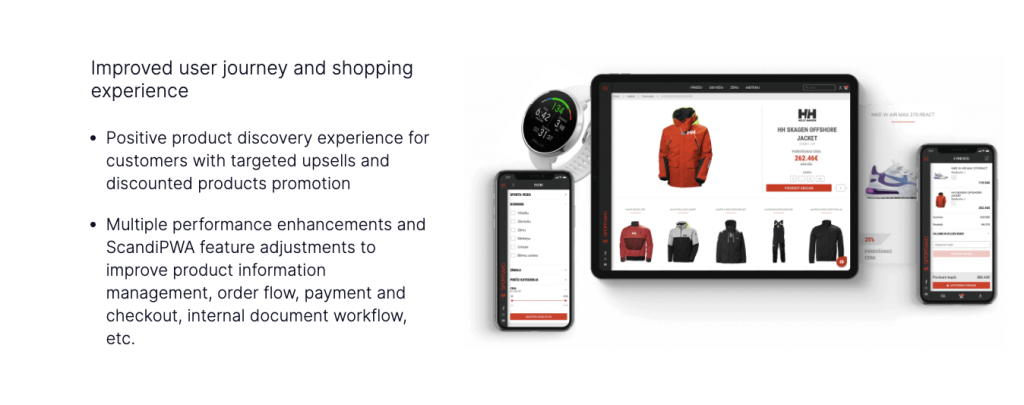
Also read:
Augmented Reality and eCommerce: Fibbl AR Implementation for Sportland
Case Study 3: Vibrant and robust Magento store that emulates Happy Socks’ creative ethos
Happy Socks is a brand celebrated for its playful and innovative range of socks and accessories. And it recognized the necessity of a digital transformation to emulate the brand’s inherent vibrancy and energy within the online space.
The challenge was to redesign its eCommerce platform to be as visually engaging as their products without sacrificing functionality or performance.
- A color-rich, visually dynamic design strategy that reflects the brand’s creative ethos
- Magento replatforming—transition to a more robust version of Magento, which provided enhanced scalability and flexibility needed to support their creative merchandising and promotional strategies
- High-resolution product images and lively graphics that capture the product’s appeal without compromising on site speed
- Strategic navigation menu redesign
- Seamless third-party systems integration
The transformation of Happy Socks’ eCommerce site into a vibrant, engaging platform not only captured the spirit of the brand but also significantly improved user experience.

The new site design aimed to make browsing and shopping as delightful as the products offered. Advanced image optimization techniques and Magento’s powerful capabilities allowed us to balance aesthetics with performance.
We redesigned the navigation menu to ensure that despite the increased visual complexity, users could find products easily and proceed through the checkout process with minimal friction
This strategic upgrade resulted in higher customer engagement, with users spending more time on the site and an increase in sales conversions. By focusing on a design that was both functional and expressive, we helped Happy Socks translate their fun and playful brand identity into a digital format that resonates with their customer base, ultimately boosting online sales and brand loyalty.
Case Study 4: Optimizing performance for Classic Football Shirts with Hyvä
Classic Football Shirts, known for its extensive collection of vintage and rare football shirts, faced significant challenges in maintaining high website performance and user satisfaction.
The complexity of the company’s inventory and the fluctuating high traffic, especially during major football events, necessitated a robust solution that could streamline their operations and enhance the overall shopping experience.
Our solution was to implement Hyva on their Magento platform to significantly improve site performance and user experience, ensuring robust support and maintenance to handle the unique demands of their eCommerce business.
- Hyvä integration—a modern front-end solution for Magento that significantly reduces load times and improves site responsiveness
- Navigation menu redesign to unify categories and simplify the user experience
- Continuous Magento and Hyvä support
- Page Speed performance score improved by 2.5x
By focusing on Hyva for their Magento platform, Classic Football Shirts now enjoys a faster, more reliable shopping experience that aligns with the expectations of their tech-savvy audience. This shift was aimed at optimizing the browsing and purchasing process, especially important for a site with a high volume of products and customer traffic.
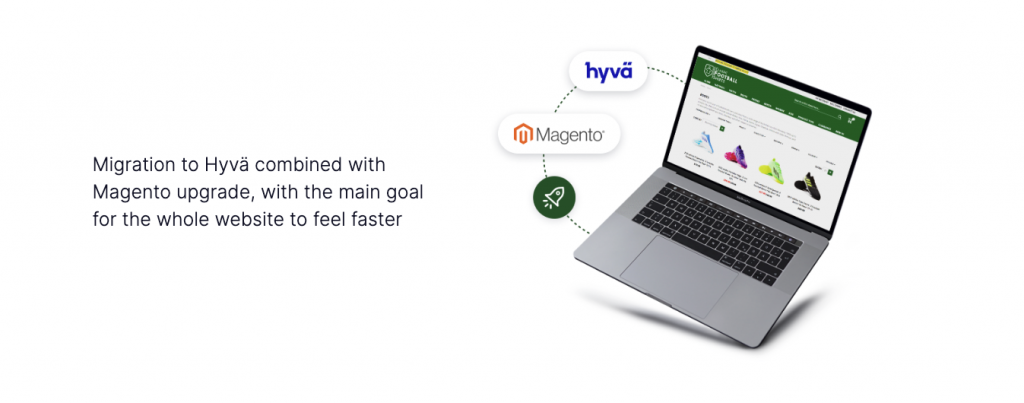
The adoption of Hyva led to a lighter, faster-loading website, which drastically reduced page load times and improved mobile responsiveness. It has directly impacted customer satisfaction by providing a smoother, more engaging user experience, leading to increased sales conversions and reduced bounce rates.
For this project, we also identified critical areas needing robust support, such as real-time inventory updates, high-traffic management, and seamless user navigation. Ensuring the platform’s stability during peak periods was a top priority.
Also read:
Case Study: 2.5x Faster Shopping Experience on Hyvä
Conclusion
Our collaborations with BUFF, Sportland, Happy Socks, and Classic Football Shirts demonstrate scandiweb’s dedication to propelling eCommerce businesses forward. We achieve this through a combination of expert Magento development, seamless migrations to Adobe Commerce, and strategic integration of advanced solutions.
These case studies serve as a testament to scandiweb’s expertise in navigating intricate industry challenges. We develop new or optimize existing platforms for peak performance, future-proof businesses with the latest eCommerce technologies, and empower them with enhanced functionality and mobile-first experiences. We craft customized, technology-driven solutions that elevate user experiences and unlock significant business growth.
Is your eCommerce store feeling sluggish or lacking the features you need to compete? scandiweb offers a range of solutions to help you propel your online success. Use the contact form below to get a free consultation with our Magento experts.
The post Magento for eCommerce Growth: Custom Solutions for the Apparel & Fashion Industry appeared first on scandiweb.
]]>The post SEO Strategy for Beauty Brands: Reaching the Top Shelf in Search Engines appeared first on scandiweb.
]]>The journey to discovering the perfect beauty brand often begins with a simple online search. And the search box leads users to an overwhelming array of options. Brands that appear at the top of search results are perceived as more credible and relevant, making a strong SEO (search engine optimization) strategy crucial.
Our collaboration with brands like Beauty Works, Slow Cosmétique, and Zohoor shows how important it is to get SEO right. We’ve helped them by developing SEO strategies that improve their visibility online, supporting them through website migrations to maintain their SEO performance, and continuously monitoring their site to adapt to changes in search engine algorithms.
This article will discuss our approach to SEO and highlight how strategic SEO efforts can help a brand maintain and improve its online presence.
SEO support during migration for Slow Cosmétique

Slow Cosmétique is a selective marketplace featuring over 300 beauty brands that proudly bear the Slow Cosmétique mention that signifies a brand’s commitment to ethical and ecological quality. Our team set out to transition this bustling marketplace from Magento 1.9 to the latest Magento version with ScandiPWA.
Project goals
The migration was also an opportunity to enhance the website’s SEO performance and user experience. Our SEO experts ensured that every aspect of the new marketplace was optimized for search engines, from the early planning stages to the final implementation, with the primary objective of increasing organic traffic while making the website more intuitive and user-friendly.
Our approach
Achieving SEO-friendly URLs was a big part of our strategy. We scrutinized and refined the marketplace’s vast array of product pages, vendor boutiques, category pages, and filtering options, adhering to SEO best practices. We aimed to create a seamless navigation experience that would make finding the perfect ethical and ecological beauty products effortless for users.
We transformed the marketplace’s structure by optimizing URLs for search engines, keeping the user in mind—we ensured that each link was intuitive, easy to follow, and descriptive of the content it led to.
Results
After the migration, the SEO team’s involvement improved search engine rankings, organic traffic, and overall user experience. For Slow Cosmétique, this meant thriving after a challenging migration and continuing to connect ethical and eco-conscious brands with their audience in a digital space that was more accessible and visible than ever.
SEO monitoring and support for Zohoor
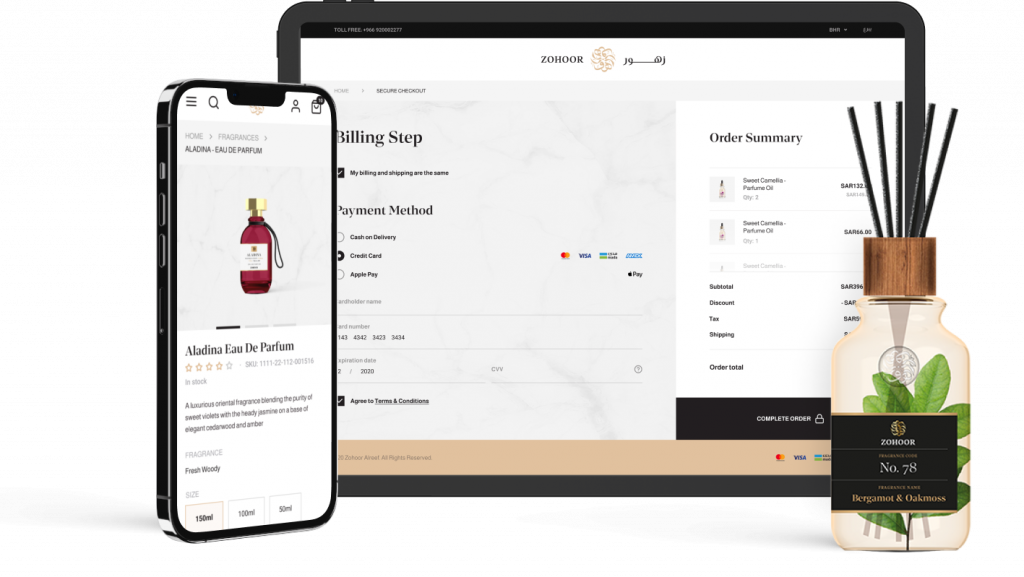
Zohoor Alreef has been a prominent player in the Middle East’s perfume industry for over three decades. We partnered up for a digital transformation project: migrating from Magento 1 to Magento 2 with ScandiPWA frontend. scandiweb SEO team’s mission was to ensure that this transition preserved the existing website’s good practices and enhanced Zohoor Alreef’s online visibility and SEO strength after migration.
Pre-migration steps
We began with a gap analysis, which allowed us to evaluate and map out what Zohoor Alreef had already mastered and identify areas to improve. This analysis covered the homepage, product listing pages, layered navigation, product detail pages, content management system, blog, and technical SEO elements such as URL suffixes, pagination, redirects, canonicals, meta robots, robots.txt, XML sitemap, hreflangs, structured data markup, meta titles, meta descriptions, reviews, and custom OG tags.
With the insights from the gap analysis, we prepared the requirements and proceeded with a pre-migration SEO audit of the staging website, verifying and addressing potential SEO vulnerabilities to ensure a smooth transition. Additionally, we did 301 mapping for a successful domain name change.
Go-live support
Our team provided on-demand support throughout the go-live phase, monitoring the website’s performance and identifying and resolving any emerging issues to minimize disruptions. A proactive approach is critical to maintaining SEO rankings and site stability during migration.
Post-go-live monitoring
Migration was successful from an SEO standpoint. Zohoor saw notable improvements in SEO KPIs post-migration—increased clicks (+12.6%) and impressions for branded and non-branded search terms. We also observed an increased number of sessions per user and average session duration, conversion rate, and total number of completed purchases, as well as backlinks and referring pages.
Significant advancements were made in the technical side of the website: page load time was reduced by 21.42%, server connection time by 62.61%, server response time by 66.72%, and page download time by 47.01%, all while keeping a steady domain rating.
SEO program for Beauty Works

Unlike migration-focused support provided in our previous case studies, this example highlights our capability to develop a full-scale SEO strategy from the ground up. We use a holistic approach, creating a comprehensive plan that integrates content optimization, technical SEO improvements, and strategic alignment with the brand’s market goals and driving tangible results through strategic SEO planning and execution.
Beauty Works stands at the forefront of influencer-driven eCommerce. With an army of social media enthusiasts and influential brand ambassadors, they have harnessed the energy of online communities to establish a strong market presence.
Our main goal was to increase non-branded organic traffic as the main valuable traffic from an SEO perspective. We also aimed to improve the Beauty Works blog, increase traffic via blog and informative content, and increase non-branded organic traffic for commercial pages.
Based on the initial review of the website, we developed a 4-month SEO strategy. Through content and technical audits conducted in the first month, we uncover more immediate opportunities, adapting based on early findings and the strategic priorities of Beauty Works.
Technical SEO
To ensure that all technical SEO issues are resolved and that nothing is holding the website back from ranking, we did a technical SEO audit, cross-checking more than 80 different technical aspects, such as indexation, internal errors, and structured data markup.
We focused on a few main areas:
- Page indexing issue resolution—reviewing issues causing 404 and soft 404 status codes, proposing solutions, and resolving indexing issues where applicable.
- FAQ implementation for PDPs and PLPs to make them more useful and show up better in Google’s search results.
- Meta description optimization to fit better with what people are searching for, helping improve the click-through rate from search results.
- Multiple technical SEO fixes for the following issues
- GeoIP redirect issue
- Blog articles that endlessly load
- Incorrectly applied HTTP status codes
- Canonical tag applied to URLs with noindex, nofollow tags
- URLs that generate a loop
- No SSR for the store view homepages & blog URLs
- Mobile header inconsistencies
- Pages with broken URL rewrites
- etc.
- SEO monitoring—setting up Content King to provide real-time SEO audit and website change tracking, finding and resolving any technical issues in a timely manner.
Website quality audit
Given that the Beauty Works website has approximately 2,000 pages generating organic traffic through more than 50,000 keywords, it was necessary to perform a website quality audit to enable effective use of SEO resources.
Website quality audit helps us to find:
- Content and products to focus on to increase organic traffic in the shortest time
- Content that is underperforming and should be merged or culled
- Similar-intent pages and near-duplicate content
- Existing product and page clustering and internal linking improvement opportunities.
During the website quality audit and 6-month traffic data analysis for Beauty Works, we spotted many areas for improvement in the overall website organic performance. We set a goal to clean up non-valuable content from the website and focus only on valuable content with opportunities to grow and rank.
Keyword gap analysis
At this stage, we analyze top competitors in the industry to identify opportunities for new content development, highlight main transactional keywords, and get a strategic overview of Beauty Works’ current market situation. From this analysis, we outline pages and topics to optimize for, as well as internal linking and other optimization opportunities.
On-page optimization
With strategic on-page adjustments, we aim to clarify content focus, improve search engine understanding, and enhance Beauty Works’ visibility and ranking for key search terms.
To tackle the drop in rankings for “near me” keywords, despite not having physical stores, Beauty Works had an opportunity to leverage its network of partner locations. We reworked the content to better rank for local searches and optimized their Google My Business profile.
We also identified internal competition between pages for certain keywords, confusing search engines on which page to prioritize. To streamline this, we established a page that serves as a hub, linking to related product pages and utilizing the continued search interest in this collaboration to boost traffic. We suggested the creation of tutorials and inspirational content for the blog. Additionally, multiple PLPs and the homepage underwent content expansion.
International SEO review
The scandiweb SEO team performed an in-depth review of the international aspect of Beauty Works business to highlight opportunities for increased organic traffic generation outside the UK and helped Beauty Works expand to the German market.
Results
A few months into our SEO efforts, we noticed a positive trend in organic KPIs YOY: +19.9% impressions, +29.2% transactions, and +21.6% revenue (June 2023 compared to June 2022). By October, the YOY revenue had reached a 121.8% increase.
Non-branded keyword performance
- +17.8% MOM
- +28.1% YOY
- Many target keywords constantly achieving the 1st positions in UK Google search results
- New featured snippets in Google SERP


During our collaboration, scandiweb also seamlessly transitioned from the old Beauty Works trade store to a new B2B site by leveraging the B2C store’s code base. The SEO team was a crucial part of this migration.
B2B SEO post-go-live performance
- +57% organic traffic after migration
- average CTR increased from 2.8% to 4.8%
- Average keyword position increased by 3 positions
Conclusion
Our SEO journey with Beauty Works, Slow Cosmétique, and Zohoor showcases the multi-faceted approach required to enhance online visibility in the Beauty industry. Technical SEO can significantly impact organic traffic and user engagement, while a comprehensive SEO strategy that includes audits, on-page optimization, and content strategy development can help rank for highly competitive keywords. SEO success requires technical optimization, strategic content creation, and continuous monitoring.
If you want to take your beauty brand’s online presence to the next level, contact us today using the form below for a free consultation. Our team of SEO experts will develop a customized strategy that addresses your brand’s challenges and goals.
The post SEO Strategy for Beauty Brands: Reaching the Top Shelf in Search Engines appeared first on scandiweb.
]]>The post Magento Development: Digital Solutions for Brands in the Food & Beverage Industry appeared first on scandiweb.
]]>Magento’s (Adobe Commerce) extensive customization capabilities allow for creating unique, engaging online stores that cater specifically to the diverse preferences of food and beverage consumers. Over the years, we’ve collaborated with multiple brands in the industry to help manage and enhance their Magento stores.
Projects launched for Läderach, Monthly Clubs, Monin, Baked by Melissa, and Greatlife demonstrate how our proactive approach to Magento development and maintenance and strategic migrations to PWA or Hyvä has paved the way for their success. They’ve been able to offer compelling, seamless, customer-centric online experiences that contribute to business growth.
The challenge
Today’s shoppers expect quick, easy-to-use websites. A slow or complicated site can make them leave before buying anything. Moreover, when moving to a new online platform or updating an existing one, brands risk losing data or experiencing operational downtime, leading to lost sales and customer dissatisfaction.
Our clients from the Food and Beverage sector faced several obstacles related to website performance, functionality, and user-friendliness that stifled their ability to expand and connect with customers.
Our approach
The following five case studies highlight tailored solutions to these challenges, focusing on strategic platform migrations, custom functionality development, and user interface enhancements. We helped our clients to overcome these barriers and enhance their website performance and customer engagement.
Case study 1: Streamlining Läderach’s eCommerce on Magento+Hyvä
Läderach is a Swiss chocolate manufacturer celebrated for its exquisite offerings and widespread distribution across over 50 countries. Our collaboration was established to migrate Läderach’s fragmented ecosystem at the time to Magento (Adobe Commerce), leveraging the modern Hyvä theme for a comprehensive redesign.
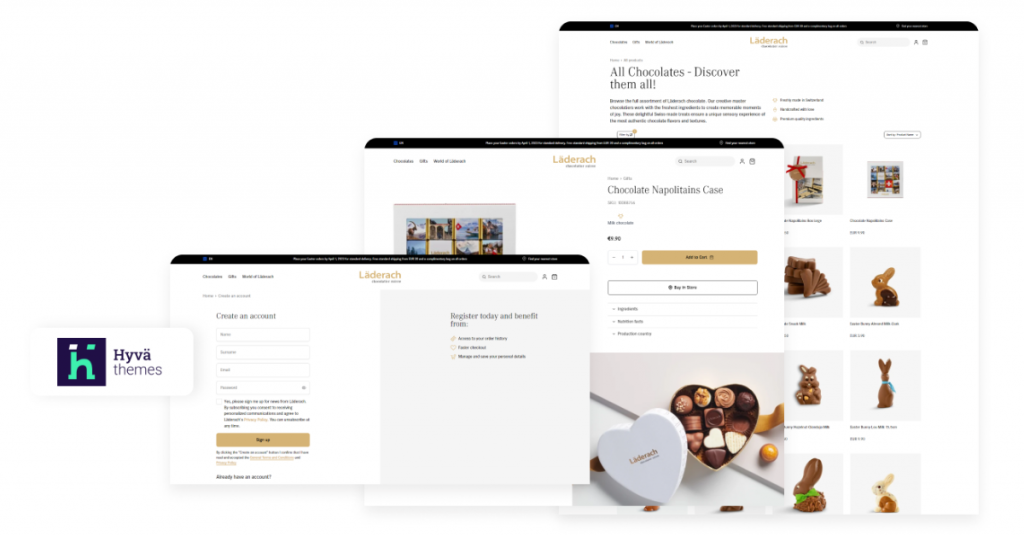
The project entailed extensive custom coding, frontend logic refinements, and ERP integration, ensuring the new platform’s stability, speed, scalability, and adaptability for future growth.
- Simplified eCommerce build that is scalable and easy to manage
- Key pages migrated to Hyvä in six months
- eCommerce architecture optimization and user experience improvements aligned with Läderach’s new store concept
- Optimized website performance, reaching a 93 PageSpeed score for the homepage and PDP on desktop and a 99 score for the PLP on desktop; all green Core Web Vitals for both desktop and mobile
- Improvements in KPIs after the Hyvä upgrade
- +25.5% average engagement time
- +4.5% engaged sessions per user
- +47.8% conversions
- +52.9% total users
- +39% revenue
The project also included new backend functionalities to ease SEO and CMS management, streamline content updates, and maintain consistent styling. By introducing gift cards and DotDigital integration for lead generation, Läderach enhanced its marketing suite, further engaging customers and driving sales.
The transformation of Läderach’s eCommerce system into a cohesive Magento solution, enhanced with Hyvä efficiency, resulted in a significantly improved online store and superior customer experience, setting a new benchmark and flexible foundation for the company’s future strategy.
Also read:
Case Study: How a Dedicated eCommerce Manager Can Help Your Business
Reaching All Green Core Web Vitals for Läderach | Hyvä Case Study
Customer Journey Gap Analysis | Läderach Case Study
Case Study: How Läderach Transformed Luxury Chocolate Digital Presence
Case study 2: Six subscription clubs under one Magento 2 roof
For over 30 years, Monthly Clubs has been committed to delivering exceptional quality and variety to its customers and subscribers. Facing the need to modernize and enhance their online presence, they approached scandiweb and embarked on a comprehensive digital overhaul to align with their longstanding principles of quality and value.
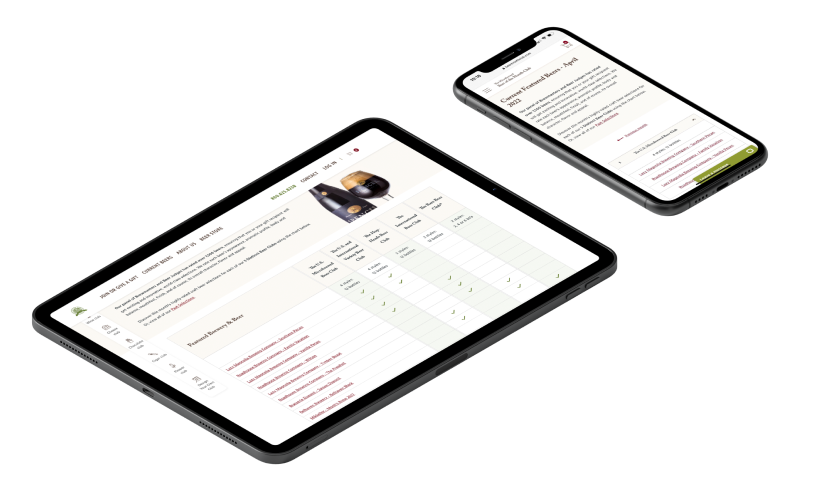
- Mobile theme launch for the oldest beer subscription club in the US
- A full-scale redesign and technological advancement of Wine Clubs
- 10+ years’ worth of data successfully migrated out of ERP to Marello
- Design your own subscription club option with the user journey adapted for both mobile and desktop
- Checkout flow and payment processing tailored specifically for the subscription business
- +96.4% average conversion rate in 2 months after the new responsive theme launch
Monthly Clubs’ transformation was multifaceted, targeting user interface and backend processes. They aimed to introduce a more engaging and seamless online experience for their subscribers, enhancing the platform’s visual appeal and functionality. The strategic roadmap outlined the implementation of new payment data management features and a focus on mobile optimization to cater to the increasing number of mobile users. We also tackled accessibility challenges, ensuring full compliance with WCAG 2.1 standards.
As a result, we saw a 58.8% reduction in shopping cart bounce rates during peak season and a 96.4% increase in the average conversion rate within just two months. Moreover, the website welcomed new customers from mobile devices, with a 42.3% increase in organic traffic acquisition after the mobile theme launch.
On the operational side, over a decade’s worth of data was seamlessly migrated from ERP to Marello, streamlining shipment and order processing and allowing the team to focus on marketing and customer care.
Case study 3: Enhancing MONIN’s digital experience with Magento 2 and ScandiPWA
MONIN, the French leader in artisanal beverage solutions, sought to enhance its digital presence to match the premium quality of its products, which are used to create over 8 million drinks daily around the globe. The objective was to modernize their eCommerce capabilities, improve site performance, and ensure a seamless user experience.
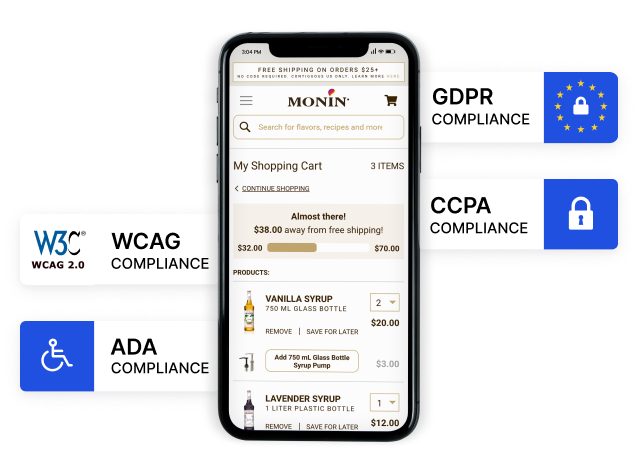
- Migration to Magento 2, coupled with ScandiPWA
- Magento platform upgrades and maintenance to ensure high performance and security
- Implementation of custom functionalities and integrations like Apple Pay and DotDigital, aimed at enhancing user engagement and conversion rates
- GDPR, CCPA, ADA, and WCAG compliance
The transition to Magento 2 aimed to revamp MONIN’s online store, which included upgrading all modules for compatibility, ensuring that the website’s intricate features like product recommendations and out-of-stock notifications—worked flawlessly.
ScandiPWA helped redefine the customer interface, delivering an app-like browsing experience that drastically reduced page load times and improved overall site usability.
Post-launch, we continued to refine the website’s functionality, offering on-demand support, debugging legacy errors from the old build, developing and integrating key extensions, optimizing site performance, and enhancing security measures with the latest security patches. Our collaboration resulted in notable improvements in site performance metrics and user engagement.
Case study 4: Customized Magento solution for Baked by Melissa
Baked by Melissa is an artisanal cupcake manufacturer with multiple stores across New York City. While they have a significant physical presence, the majority of their business is driven through eCommerce. Recognizing the potential to enhance customer engagement and repeat business, Baked by Melissa wanted to implement a customized events calendar reminder system on their Magento platform.
The primary goal was to develop an events calendar that allows customers to save important dates, such as birthdays and anniversaries, and receive timely email notifications to order cupcakes for their celebrations. This functionality was built on Magento Commerce, incorporating event registry features with bespoke designs and templates tailored to Baked by Melissa’s branding and user experience requirements.
Project highlights
- Integration and customization of event registry functionality to support the unique needs of Baked by Melissa’s client base
- Klaviyo integration to streamline email notification processes
- 24/7 support and ongoing maintenance for a smooth operation of the new features
The events calendar and customized event registry, new login popup feature, and other new functionality implemented by scandiweb gave the client a powerful tool to increase engagement and strengthen customer relationships, showcasing the potential of customized Magento solutions to foster customer loyalty.
Case study 5: Magento platform enhancements for GreatLife
GreatLife, a leading seller of organic dietary supplements in the Nordics, wanted to refine the existing eCommerce infrastructure and introduce new functionalities that align with the market needs.
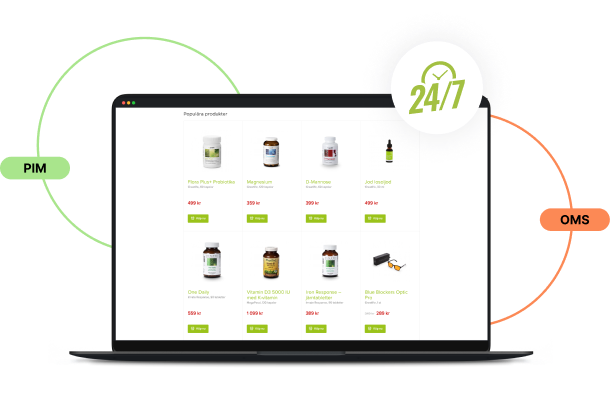
- Full tech setup of the stores for EU and Nordic markets
- eCommerce ecosystem enhancements—OMS and Akeneo integration with Magento
- ProfitMetrics integration for optimizing the profitability of sales channels and marketing campaigns
- Proactive development, CRO, and SEO support brought +78% transactions
We performed timely Magento version and security upgrades to improve site performance and stability. Klaviyo integration for email marketing and Klarna payment solutions, along with the development of loyalty programs and subscription plans, enhanced customer engagement and retention. Backend efficiency improvements, including the simplification of site navigation and updates to modules, further optimized the operational workflow.
The GreatLife platform saw an increase in conversions by 50%, and transactions increased by 78% (+94% transactions from organic search). This project also contributed to a 29.4% increase in revenue.
Conclusion
The success stories in this article reflect the impact a focused, customer-centric approach can have on eCommerce businesses in the Food and Beverage industry. We’ve streamlined shopping experiences and introduced features that resonate with the modern consumer’s expectations while keeping the base—Magento platform—secure and stable.
Hungry for an upgrade of your eCommerce store? Let us help you migrate to Magento or enhance your existing website. Use the contact form below to set up a free consultation, and our Magento experts will get back to you shortly.
The post Magento Development: Digital Solutions for Brands in the Food & Beverage Industry appeared first on scandiweb.
]]>The post Tailored Magento Development: Success Stories from the Beauty Industry appeared first on scandiweb.
]]>In the competitive beauty and cosmetics sector, a seamless online experience is essential for attracting and retaining customers.
Our projects with Beauty Works, Slow Cosmétique, and Zohoor showcase how our targeted Magento development, including ScandiPWA implementations and strategic migrations, directly addresses these industry needs.
This collection of case studies unfolds our approach and the tangible business growth our clients achieved, showcasing the importance of precision in eCommerce solutions.
The challenge
From ensuring an engaging user experience to managing complex product inventories, businesses need to stay ahead in a market that values speed, aesthetics, and accuracy above all. Our clients, despite their strong brand identities and quality products, faced hurdles that hindered their potential for online growth.
- The modern consumer expects lightning-fast load times and smooth navigation. Any delay can lead to lost sales and diminished brand perception.
- A cluttered or unintuitive online store can hinder even the most interested buyers. The goal is to make finding and purchasing products as straightforward as possible.
- Moving to a new platform or upgrading an existing one is fraught with risks, from data loss to downtime, affecting both sales and customer trust.
Each of these challenges required a nuanced understanding of both the technical and business aspects of eCommerce, demanding solutions that are as innovative as they are effective. Our approach was to tackle these issues head-on, using a mix of technology, creativity, and deep industry insight.
Our approach
Addressing the unique challenges of the beauty and cosmetics industry requires a comprehensive and flexible strategy. Our focus centered on leveraging Magento’s robust platform capabilities to deliver exceptional online experiences. Here’s how we tailored our solutions to meet and exceed our clients’ needs.
Tailored Magento development
Recognizing Magento’s flexibility, we customized its features to align with the specific requirements of each client. This included everything from the storefront’s look and feel to the backend processes that ensure operational efficiency.
Risk-mitigated migrations and upgrades
We approached migrations and platform upgrades with a meticulous plan that minimized downtime and data loss. By carefully strategizing each step, we ensured a smooth transition to more advanced systems, safeguarding both the customer experience and our clients’ reputations.
In every project, our priority was not just to solve the immediate problems but to set up our clients for long-term success. This meant not only addressing current eCommerce trends but also anticipating future needs, ensuring scalability, and providing the tools for ongoing optimization. Through close collaboration with our clients, we implemented solutions that often exceeded their expectations, demonstrating the power of a strategic, client-focused approach in the digital space.
Case Study 1: B2C and B2B solutions for Beauty Works
For Beauty Works, a leader in the hair extension market, the challenge was twofold: revamping the B2C eCommerce site to improve the customer shopping experience and enhancing the B2B portal to streamline the ordering process for salon partners.
Our objectives were clear: to increase efficiency, elevate the brand’s online presence, and ultimately, drive sales growth.
- Website redesign focused on a mobile-first approach, considering the growing trend of mobile eCommerce, which resulted in a significant boost in mobile engagement and conversions
- Cost-efficient development where the B2C store was duplicated to create a B2B portal that simplified the ordering process for salon partners
For the B2C store, a comprehensive Magento development approach was undertaken, focusing on implementing ScandiPWA for a seamless and responsive user experience. Emphasizing a mobile-first strategy, the project aimed to optimize the eCommerce platform for mobile devices, recognizing the growing trend of mobile shopping. This redesign enhanced the visual and operational aspects of the Beauty Works website as well as ensured faster load times and a smoother navigation experience. The focus was set on boosting user engagement and sales conversions directly from mobile devices.
The B2B store project was tailored to meet the specific needs of business clients, focusing on enhancing the B2B eCommerce experience through Magento development. This included features like quick order forms, custom pricing, and a streamlined checkout process, making it easier for salons to do business with Beauty Works.
Also read:
Shared code base between B2C and B2B websites for cost-efficient development and maintenance
Case Study 2: Enhancing eCommerce capabilities for Slow Cosmétique with Magento 2 and ScandiPWA
Slow Cosmétique, committed to promoting a more conscious approach to beauty, needed an eCommerce solution that could handle a robust marketplace and enhance user experience. Our goal was to create an engaging, efficient, and scalable online store using Magento 2 with the integration of ScandiPWA for a seamless frontend experience.
- Migration of Slow Cosmétique marketplace from an older Magento platform to Magento 2, enhancing its capabilities with ScandiPWA
- ScandiPWA implementation to provide a faster, more responsive user interface
- Focus on SEO and mobile user experience, understanding that a substantial portion of users would access the site through mobile devices
- All-green CWV and 92.31% increase in mobile conversion
The transition to Magento 2 was designed to streamline operations and enhance the user experience, with a focus on maintaining a strong, ethical brand identity through a robust eCommerce platform. This upgrade was critical to support the intricate features required by their marketplace, such as custom ERP, payment processing, and vendor management with Unirgy.
Implementing ScandiPWA significantly improved page load times and overall site performance, resulting in all-green Core Web Vitals (CWV). It also allowed for optimizing the mobile user journey, which was crucial for boosting mobile conversions.
The new platform modernized Slow Cosmétique’s web presence and brought significant enhancements in user navigation and engagement, which contributed to an impressive 92.31% boost in mobile conversion rates.
Also read:
Case Study: All-Green Core Web Vitals and 92.31% Boost in Mobile Conversions
Case Study: eCom Marketplace on Magento 2 with ScandiPWA and Unirgy
Case Study 3: Elevating the fragrance experience with Zohoor
Zohoor, renowned for its exquisite line of fragrances, aimed to enhance its online presence to better reflect the sophistication and quality of its products. The project was centered around a comprehensive redesign of Zohoor’s eCommerce site, focusing on an intuitive and visually appealing user experience that would attract and retain customers.
- Data-driven redesign of the Zohoor eCommerce site
- ScandiPWA integration to allow for greater scalability and customization
- 12.5% boost in conversion rates and 24% increase in average page views per session
We undertook a full redesign of the Zohoor eCommerce site, focusing on creating a visually rich, user-friendly, and highly converting UX. High-resolution product images, elegant color schemes, and a simplified navigation structure were implemented to make it easy for customers to browse and purchase their favorite scents. This design approach was intended to mirror the luxurious nature of Zohoor’s products and elevate the overall shopping experience.
We integrated several custom features specifically tailored for Zohoor’s market, including scent discovery tools, a store locator supporting 29 stores across the Arabian Peninsula, and mobile-native social share capabilities on product detail pages. Enhancements like Apple Pay integration and special promotions via Amasty for ScandiPWA also contributed to a seamless and enriched customer interaction.
This project with Zohoor underscores the power of a thoughtfully designed eCommerce experience. By aligning the online store with the brand’s luxury image and leveraging Magento’s capabilities, we were able to drive significant business results, showcasing scandiweb’s ability to adapt and innovate in the face of evolving market demands.
Conclusion
Our projects with Beauty Works, Slow Cosmétique, and Zohoor demonstrate our commitment to elevating eCommerce platforms through expert Magento development, innovative ScandiPWA implementations, and strategic migrations.
These case studies illustrate scandiweb’s ability to overcome significant industry challenges, enhance user experience, and drive substantial business growth through tailored, technology-driven solutions. By consistently focusing on customer needs and staying ahead of technological trends, we ensure that our clients meet their immediate goals while also preparing them for future opportunities.
Ready to upgrade your eCommerce store? Migrate to Magento or upgrade your existing store with new functionalities. Use the contact form below to get in touch with our Magento experts.
The post Tailored Magento Development: Success Stories from the Beauty Industry appeared first on scandiweb.
]]>The post Beauty & Cosmetics: Unique Customer Experiences for eCommerce appeared first on scandiweb.
]]>What happens after a click of a button or a tap on the screen can either seal the deal or break the connection with your customers. So, yes, the online experience you offer is not just a part of your business—it is your business.
For those steering the ship in eCommerce, the message is clear: innovate or stand still.
Our journey into enhancing the customer experience (CX) for the beauty and cosmetics industry showcases our commitment to innovation and blueprint for growth and increased revenue.
Honing into our collaborations with brands like Beauty Works, Lancôme, and Zohoor, let’s explore how personalized shopping experiences and robust loyalty programs can be the foundation of a thriving online presence that resonates with customers and keeps them coming back for more.
The brands

Beauty Works
Beauty Works is recognized primarily for its presence in the luxury hair extension and haircare products market. Based in the UK, the brand caters to a diverse market looking for high-quality, durable hair extensions along with premium haircare and styling tools.
With over 4,000 salon partners worldwide and a strong social media following, Beauty Works offers premium hair extensions and haircare essentials that reach millions around the globe. The brand operates in both consumer retail and professional salon sectors, serving individual consumers as well as hairstyling professionals seeking top-tier products for their clientele. Its eCommerce store delivers to more than 190 countries across six continents.
Lancôme
Established in 1935, Lancôme is a symbol of French luxury in the beauty industry. Known for its high-end cosmetics, fragrances, and skincare products, the brand has maintained a consistent premium identity over the years, symbolizing elegance, sophistication, and reliability. In 1964, Lancôme became a part of the L’Oréal Group.
Lancôme has over a thousand boutiques in France and many more around the world. Its products are sold in more than 140 countries on three continents—America, Asia, and Europe. The brand has dedicated eCommerce stores in 34 countries and has fully embraced digital innovation by offering virtual experiences to its customers.
Zohoor
Zohoor is a distinguished Saudi perfume brand blending Arabian heritage with inspirations from around the world. This approach positions them as artisans and mixologists who narrate stories through their exceptional perfume-making craft.
The brand specializes in crafting unique fragrances that are personalized for individual expression, taking customers on a sensory journey that allows them to define their own fragrance signature. Zohoor has been a prominent player in the perfume industry for over 30 years.
Personalized shopping experiences: The heartbeat of online retail
With all the advancements in technology and eCommerce companies constantly keeping up with new trends and innovations in the industry, personalized shopping experiences have become an essential luxury. Consumers expect it.
Recognizing this, our approach has always been to put the customer at the center of the universe, creating tailored experiences that speak directly to them. Here’s how we did it.
Understanding the customer
Leveraging advanced analytics and customer data, we’ve been able to understand not just what customers are buying, but where and why. This insight has been pivotal in crafting personalized content, recommendations, and promotions that resonate on a personal level.
Beauty Works
Beauty Works has a very strong social media following and have collaborated with influencers with multi-million followers on Instagram (IG). With 96% of its traffic coming from mobile devices and its main social media channel, the brand implemented a social shop feature—rending IG posts on product detail and CMS pages based on hashtags. To support this, a mobile-first development approach was taken and a native-app like experience was achieved through PWA.
The brand met its customers where they were and presented its offerings in the shape and format its audience was familiar with.
Lancôme
Lancôme launched its Hypnôse Star Mascara with Betty Boop as a virtual consultant joining customers through their shopping journey and helping them find the right products according to their needs and preferences. Known for her glamorous and playful persona, Betty Boop was the perfect fit for this role, embodying the charm and allure that the mascara promises. Her presence on the website added a fun, engaging touch to the shopping experience, helping customers feel more connected and entertained as they explored products.
Betty’s timeless appeal and her association with classic Hollywood glamor brought a unique and memorable dimension to Lancôme’s campaign.
Zohoor
Zohoor took their customer experience to a new level with a data-driven redesign on ScandiPWA, which incorporated CRO analysis to optimize website architecture and an intuitive user experience focused on increasing conversions.
The redesign resulted in a significant 12.5% increase in conversion rates, accompanied by a 24% rise in page views per session and a 17% boost in organic traffic, indicating a more engaging and efficient site.
Zohoor also introduced the Mixology Journey, a unique feature allowing customers to create their own personalized perfume blends by combining various fragrances in precise proportions. This innovative approach not only provided a customized product but also enhanced the interactive aspect of the shopping experience, deeply resonating with customers looking for a tailored fragrance experience.
The role of personalization and endorsement
Personalization and endorsement play crucial roles in elevating the customer experience and boosting brand loyalty in the digital marketplace. By integrating personalized features, like Lancôme’s virtual consultant Betty Boop and Zohoor’s Mixology Journey, brands create an engaging and unique shopping experience that resonates deeply with consumers. Similarly, endorsements from recognizable figures and effective use of social media, as demonstrated by Beauty Works, enhance credibility and attract a larger audience, ultimately driving conversions and fostering customer retention.
Impact on sales and loyalty
The proof, as they say, is in the pudding. By offering a shopping experience that felt personal, intuitive, and engaging, we saw a significant lift in conversion rates and repeat purchases. Customers felt understood and valued, translating into stronger brand loyalty and advocacy.
Beauty Works’ revenue soared by 32% year over year after migration to PWA. Lancôme’s Hypnose Mascara online campaign was the most financially successful the brand had experienced at the time of its launch. Zohoor saw a 12.5% conversion rate increase immediately after the date-driven redesign of its website.
Transforming online shopping with AR try-ons
The beauty industry thrives on personalization and the tactile experience of trying before buying. Yet, the digital frontier presented a challenge: how do you replicate the in-store experience online?
Lancôme addressed this by introducing an innovative solution: a virtual try-on experience powered by augmented reality (AR) technology.
Lancôme’s AR try-on technology represented a significant leap forward in online shopping. It addressed the inherent limitations of eCommerce by offering a tangible, interactive experience that closely mirrored the in-store experience. The substantial increase in user interaction and conversion rates following the implementation of this technology was a testament to its effectiveness and the importance of AR in the beauty and cosmetics retail industry.
The virtual mirror experience
Lancôme’s “Virtual Mirror” enabled customers to try on the Hypnose Mascara virtually and see firsthand how it would enhance their eyelashes.
This integration of AR on Lancôme’s website didn’t just add a layer of interactivity—it revolutionized the customer’s shopping journey. By allowing users to visualize product effects in real-time, Lancôme empowered customers to make informed purchase decisions.
Virtual Mirror provided a personalized, interactive experience, allowing customers to experiment with products from the comfort of their homes.
This level of personalization and interactivity was unprecedented. It set a new standard for online cosmetics shopping.
Impact on engagement and sales
The online campaign on the Hypnose Mascara was the most financially successful for Lancôme at the time it was launched, a clear indication of the AR feature’s effectiveness.
The technology significantly boosted user interaction, encouraging more customers to engage with products deeply. This increased engagement translated directly into higher conversion rates, as customers felt more confident about purchasing.
Through the AR try-on feature, Lancôme not only addressed the inherent limitations of online shopping but also set a new benchmark for customer interaction and satisfaction. The success of the Hypnose Mascara campaign, bolstered by AR technology, underscores the transformative potential of digital innovations in the beauty industry.
Cementing brand allegiance with customer loyalty programs
Cultivating customer loyalty in a crowded market
In the fiercely competitive beauty and cosmetics industry, fostering customer loyalty is a challenging feat. To turn casual buyers into brand advocates, brands must create a bond that transcends the occasional purchase.
Beauty Works and Zohoor understood this, implementing loyalty programs that not only reward repeat purchases but also deepen the customer-brand relationship through personalized experiences and exclusive benefits.
Rewarding loyalty
Beauty Works introduced a straightforward yet compelling loyalty gesture—free gifts automatically added to customers’ carts based on promo conditions. This approach delighted customers and encouraged additional purchases.
By aligning rewards with customer preferences, Beauty Works enhanced the perceived value of each transaction, fostering a sense of appreciation and belonging among its clientele.
Meanwhile, Zohoor introduced gift cards along with special promotions. These initiatives offered dual benefits: they provided customers with flexible gifting options and exclusive deals, while simultaneously encouraging exploration of Zohoor’s extensive product range. The result was a loyalty program that felt both rewarding and personalized, encouraging repeat business and enhancing customer satisfaction.
Conclusion
Our collaborations with Beauty Works, Lancôme, and Zohoor showcase the transformative power of focusing on customer experience in eCommerce.
We used smart analytics to create personal shopping moments, introduced AR try-ons for a virtual yet real feel, and built loyalty programs that make every customer feel special.
These steps led to big wins: more people buying, more often, and a real buzz around the brands.
The stories we shared here are about proving how a great customer experience can turn browsers into buyers and buyers into loyal customers. It’s a lesson in how innovation and attention to what customers really want can lead to success in the competitive beauty and cosmetics eCommerce market.
Want to create customer experiences tailored for the beauty and cosmetics market? Use the form below to get a free consultation. Once we’re clear about where you are and where you want to get to, we can start shaping a customized strategy that aligns perfectly with your business goals.
The post Beauty & Cosmetics: Unique Customer Experiences for eCommerce appeared first on scandiweb.
]]>The post SEO Plan to Reach 60,000 Beauty Industry Customers in 1 Year appeared first on scandiweb.
]]>With the launch of a new eCommerce store on the horizon, a beauty brand faces the challenge of entering a competitive market. To become successful, they need to foster a seamless omnichannel presence that resonates with customers locally and globally.
To showcase the impact organic search can have and how to leverage that, we’ll detail an SEO plan we developed for a Canadian brand in the Beauty industry, describing the methodology and tactics to reach 60,000 customers within a year.
How scandiweb SEO can help
We cover two different SEO directions: local and eCommerce SEO.
For in-store traffic (local SEO), we leverage local SEO tactics to enhance visibility in physical store locations. This includes setting up and optimizing Google My Business profiles, ensuring the store appears in local listings and directories, and optimizing beauty service pages with local keywords. Additionally, the contact page will undergo optimization to make it easier for local customers to find and visit the store.
For online store traffic (eCommerce SEO), we create an SEO-friendly category tree and main menu to ensure product categories are easily navigable and search engine friendly. It’s optimized to capture low-hanging, long-tail keywords related to product categories. Product pages will receive a comprehensive optimization, focusing on core products and services, ensuring they rank high for relevant searches. The content strategy will target transactional keywords with informational SERP intent, providing valuable content that meets the user’s search intent while guiding them toward making a purchase.
Let’s break down our SEO strategy for a beauty brand step by step!
Our SEO strategy
Phase 1: Pre-launch
This stage is about establishing a solid foundation for SEO, content strategy, technical functionality, and user experience. Pre-launch activities include supporting website structure development and SEO of core content—categories, products, and services to ensure the website is SEO-friendly for users (on-page) and search engines (technical side). We’re setting the ground for further on-page and off-page optimization.
SEO work is tied closely to different aspects of marketing and website development. At this stage, you want to begin building a relationship with the potential audience—capturing leads, supporting subscribers, and engaging with them via email marketing. Correctly set priorities and scope of work will ensure the growth of organic traffic and revenue.
The two different SEO directions in the pre-launch phase focus on the following:
1) eCommerce SEO
- Creation of product-related pages to attract online shoppers to the client’s eCommerce store
- Targeting broader product-related keywords
- Targeting customers in all user journey stages with a focus on buying intent
- Main goal: revenue from online purchases.
2) Local SEO
- Targeting local searches to attract nearby customers to a physical business location
- Incorporating location-specific keywords and phrases
- Targeting users seeking local solutions or services, aiming to drive them to visit a physical store
- Main goal: online bookings and physical store visits.
SEO potential & insights
It’s important to set the right expectations when entering a market with established players and high keyword search volumes. In the Beauty industry, competition in Google is tough. However, despite several market dominators, SERP analysis revealed opportunities for newcomers.
When assessing competitors with similar product offers, it is evident that Sephora and Ulta are leading in the Canadian market in terms of SEO. Reviewed competitors have a strong online presence, domain authority, content depth, backlink profile, and brand recognition. They’ve likely invested years in building their SEO strategies, which can make it difficult for a new website to catch up quickly.
SEO takes time.
Gaining trust from search engines and users requires consistent effort and a history of quality content and interactions.
While the market is challenging, players with low authority and domain ratings have earned positions in the top 20 of Google’s SERP, which is a positive indicator. Despite the competition, there is room for growth and success through strategic SEO practices, consistent content creation, and smart optimization techniques.
Comparing main market competitors and established giants with smaller brands, we observed that domain age does not play a significant role. What matters are backlinks, brand authority, and domain rating, while content, page amount, and full semantic coverage are crucial.
Keyword opportunities
The beauty industry has an expansive keyword universe, and our strategy would be to target mid- and short-tail keywords (with higher keyword difficulty) in the mid- and long-term and aim for long-tail keywords in the short-term to drive organic sales as soon as possible. Let’s look at specific product and service keyword opportunities for eCommerce and local SEO.
Beauty product groups
Based on a SERP review of 7 keyword groups, e.g., hair products, makeup products, the steps are:
- Prioritize makeup keyword group as the best potential intent match and lower competition
- Focus on long-tail keywords with lower keyword difficulty and intent match
- Focus on specific product category optimization and creation
- Target product + near me keywords for local SEO.
Brand
Due to high competition with branded websites and current beauty giants, ranking for well-known brand-related search queries will be challenging. These are our suggested focus areas:
- Develop brand pages—long-tail keywords with lower keyword difficulty and optimized brand-specific landing pages are required to outcompete competitors
- Focus on the most searched product and page optimization.
Fragrance
Based on initial research, there is high competition for fragrances. Google SERP and intent target perfume stores and giants such as Sephora, Walmart, and Amazon. Possible opportunities and directions:
- Create a perfume brand landing page
- Optimize specific perfume PDP
- Create a fragrance/perfume finder page based on specific notes
- Use keywords like perfume stores near me to target local stores.
Wellness and general services
- Service pages have a high potential for local SEO as the goal is to bring customers to a physical location
- eCommerce SEO opportunities—focus on long-tail keyword optimization with lower keyword difficulty and intent match, optimize specific service pages, strengthen page value with internal linking to specific service-related procedures, prices & booking/appointment opportunities, and cover French keywords that are less competitive with a higher short-term ranking potential.
Specific treatments
- Local SEO opportunities are high—focus on ranking for near me keywords in the local area
- eCommerce SEO opportunities—focus on long-tail keyword optimization with lower keyword difficulty and intent match, create specific procedure pages, strengthen service page value with informational content to give customers as many details as possible about the procedure, and cover French keywords that are less competitive with a higher short-term ranking potential.
Website structure & content optimization
Through semantic mapping exercises and competitor and keyword research, it’s possible to define an SEO-friendly website structure, provide recommendations for page wireframes, and define content optimization guidelines on the individual page level.
Semantic mapping of core product groups and services helps to identify the essential attributes of the core product entities and their relationships with other relevant entities within the context that potential buyers might find interesting. Semantic mapping for service pages is similar. We need to ensure that customers can find services through every possible angle associated with them in the local area.
Benefits of semantic mapping
- SEO-friendly website navigation creation, logical category tree development, and recommendations regarding specific page creation
- A complete overview of the client’s service and product offering, making the optimization process more structured and efficient
- Workflow naturally extends to English and French as entities and attributes are language-agnostic, unlike keywords
- Creating semantically rich content that covers any possible angle users might be interested in to future-proof the website, which is especially important in the age of AI and large language models.
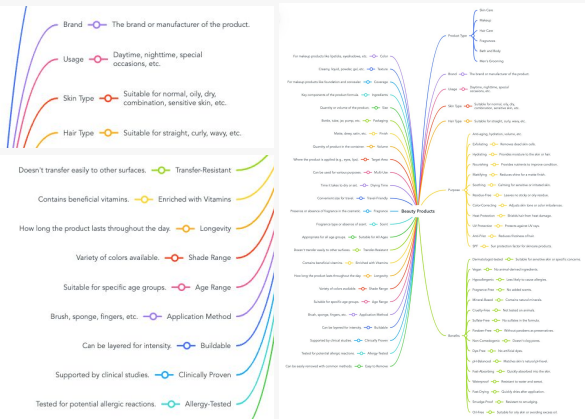
Depending on internal resources, the scandiweb SEO team supports the brand with content guidelines for copywriters in English and French, as well as text outline preparation, copywriting, proofreading, and translations.
Category page optimization includes optimizing meta titles and descriptions for categories and subcategories, expanding filtering options based on semantic mapping and keywords people use to find products that cover every angle and best meet the user intent, internal linking optimization and navigation suggestions, and SEO content guidelines and development.
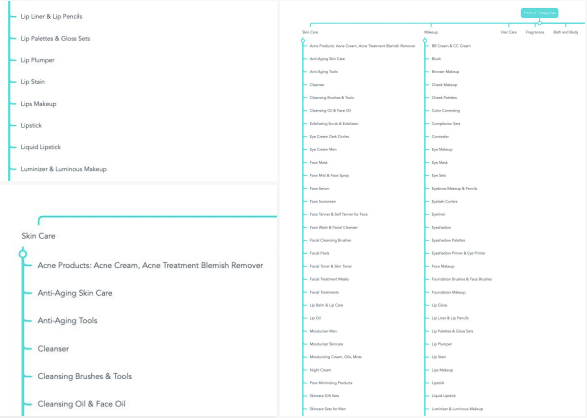
Competitor and keyword research
Content gap analysis is an essential initial workflow that we undertake before providing specific recommendations. It involves several key steps:
- Carefully identifying competitors—incorrect competitor selection can result in data that is not aligned with search intent
- Conducting keyword analysis to determine areas where content is lacking or insufficient
- Mapping discovered keywords with existing pages or recommending new page creation once the content gaps are identified.
Brand page optimization covers optimizing meta titles and descriptions for categories and subcategories, expanding filtering options based on semantic mapping and keywords, for example, through internal linking and buttons on brand category pages to achieve intent and keyword depth based on brand + product type searches.
Product and service description page optimization
- Optimization of meta titles and descriptions
- Create optimized product descriptions with relevant keywords
- Provide semantic recommendations on PDP must-have content blocks to cover and reach search intent
- Prepare guides on technical must-have elements implementation, such as alt tags, image formats, structured data, and FAQ.
Technical SEO
Technical SEO is the foundation of any successful website, and optimal setup ensures further optimization efforts are not hamstrung. With a solid technical foundation, the website can effectively communicate with search engines, set the stage for improved organic rankings, and provide users with a seamless browsing experience.
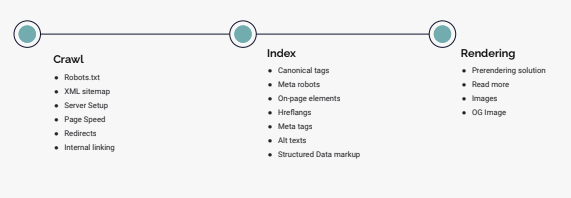
Well-defined technical SEO requirements, close cooperation with the development team from the start of the project, implementation of technical SEO best practices, and several waves of technical SEO audits before the website launch will allow development resources to be saved in later stages.
Lead capture
To develop a solid foundation for successful subscriber collection and brand introduction, the brand needs to combine effective SEO practices, UX, backlink, and PR efforts and optimize their pre-launch page. Collecting subscribers and building domain authority before the eCommerce store launch while offering early access involves two strategies.
1) Backlink building
- Outreach strategy to identify influencers, bloggers, and websites in the industry for potential backlinks
- Prepare guest articles for relevant websites with a link to the pre-launch page
- Collaborate with related businesses for mutually beneficial backlink opportunities
- Craft press releases announcing the pre-launch and unique value proposition.
2) Pre-launch optimization
- Optimize the main landing page with persuasive language and keywords that align with your SEO strategy
- SEO metadata, compelling headline, and value proposition
- Highlight the incentives—discounts, exclusive content—visitors will receive upon subscribing
- Display trust badges, testimonials, or endorsements to build credibility.
Phase 2: Launch
During the second stage, the focus shifts from preparation to execution and monitoring. This is where all the meticulously laid plans of the pre-launch phase are put to the test.
eCommerce store go-live support and monitoring
First, we have to guarantee that the website is fully accessible to search engine bots and that every element of the website is correctly rendered, crawled, and indexed. It’s crucial to cross-check all SEO configurations and settings on the live site. Launching a website can sometimes introduce unexpected bugs that affect SEO elements; therefore, immediate identification and fixes of these issues prevent any negative impact on the site’s search engine performance.
Local SEO
The launch phase also emphasizes configuring local SEO elements to improve the business’s online visibility for local searches and attract potential customers within the same geographical area. Actions include verifying and optimizing Google My Business listings, ensuring consistent local citations, and incorporating location-specific keywords into the site’s content. The goal is to make it as easy as possible for local customers to find and visit the physical store or to engage with the business online for local services and bookings.
Phase 3: Post-launch
After the website launch, we focus on ongoing content optimization and backlink building to target more mid- and short-tail keywords, new page type and content creation, KPIs monitoring of the KPIs, and continuous testing and iterations. The following were our suggestions for the Canadian beauty brand.
Transactional and informational content development
Considering the size of the brand’s product stock and variety of services, we suggest optimizing and experimenting with transactional content after launch. Moreover, there are various opportunities for targeting informational keywords:
- Mass, premium, and luxury cosmetics targeting by price range
- Guidelines to help users choose and purchase the product
- Quizzes and buying guides
- By quality
- By skin, hair type, etc.
- Product comparison pages
- Service comparison pages
- Tutorials
- Gifts.
Backlink building
Backlink building, already started in the pre-launch phase, is crucial for SEO. Incoming links drive direct referral traffic and enhance the website’s authority and visibility in search results, ultimately boosting its chances of ranking higher.
The number and quality of backlinks required for each target page are determined per page through thorough SERP analysis. After optimizing the content, we enable link-building activities. This allows us to allocate resources efficiently and quickly assess the results. The sources for acquiring backlinks are agreed upon individually with the client.
We focus on the following backlink-building strategies:
- Free directories and local business and services listings to showcase business details online, boost visibility, attract local customers, and improve search rankings
- Link buying through content marketing by creating valuable content and collaborating with relevant websites to acquire high-quality backlinks
- Press releases and influencer marketing to generate organic backlinks and increase brand visibility.
Additional insights
For the Canadian beauty brand, we identified a preliminary 10,000 low-hanging keywords relevant to their services, products, and premium customer segment. It is only 5% of Sephora’s total keywords, which means there is much bigger potential overall.
Ranking for these keywords can bring the following organic traffic to the website & Google Business Profile:
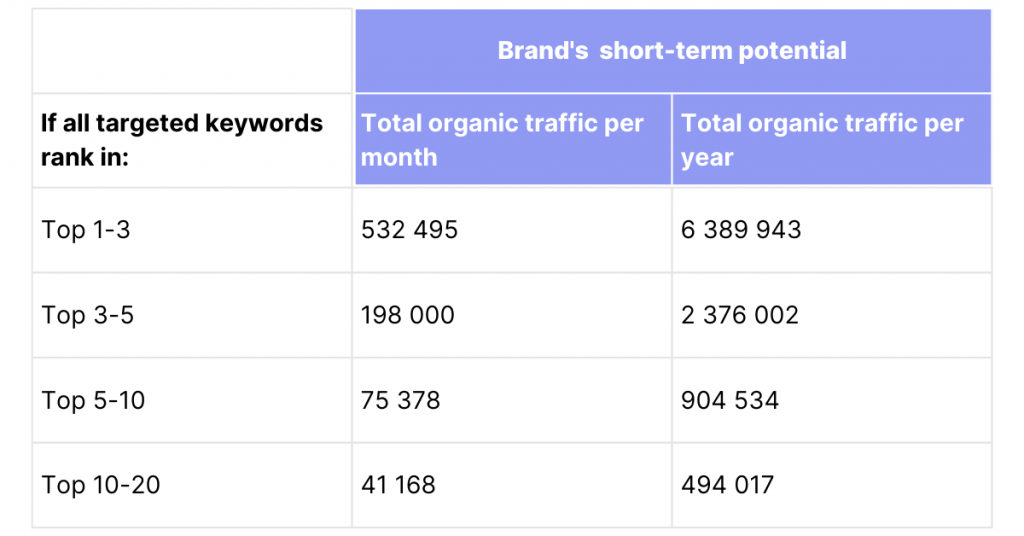
Our research shows that even if the brand gets into the 20th Google position for low-difficulty keywords by the end of the year, they will receive ~430,000 organic visits on the website, over-reaching the goal of online store visits by two times only from organic channels.
Another thing to remember is that the target customer shopping for beauty products will rely on an omnichannel presence to make buying decisions. In addition, social media is the new search engine for younger consumers. While Instagram, YouTube, Facebook, and TikTok will be the most cost-effective social media outlets for communication, beauty brands need to take them into consideration for search behavior as well. For Gen Z and millennials, social networks are the top channel for researching products, with 47% using them to weigh up their purchases.
Wrapping up
SEO is only one of the success factors when launching a fresh site in the Beauty industry. The goal is not just to bring more organic traffic but to generate more revenue in both online and offline channels. scandiweb’s cross-functional team can consult with and support brands on every aspect of lifecycle marketing and eCommerce.
Are you ready to make your beauty brand’s online presence known? With over 20 years in the industry and 600+ completed projects, our team is up for any challenge! Send us a message today and start with a free consultation.
The post SEO Plan to Reach 60,000 Beauty Industry Customers in 1 Year appeared first on scandiweb.
]]>The post Enterprise CMS Platforms for eCommerce: Insights and Trends appeared first on scandiweb.
]]>Content Management Systems (CMS) deliver seamless, scalable, and feature-rich online shopping experiences. However, choosing the right CMS platform depends on each eCommerce business’s unique needs and goals.
Key trends in the CMS market
- A growing number of active websites that use CMS platforms
- The surging prevalence of cloud computing adoption
- Widespread implementation of CMS across diverse industry sectors
- Rising demand for digital marketing and eCommerce solutions
- Escalating consumer expectations for seamless omnichannel experiences
- Increasing usage of mobile devices
- Continuing the BYOD (Bring Your Own Device) trend due to the popularity of hybrid work models
Composability & headless
The rise in mobile and web applications requires brands to adapt to omnichannel experiences, considering diverse digital channels. Legacy platforms struggle with related to re-platforming, while modern headless CMS proves flexible, cost-effective, and future-proof. Cloud innovation, especially serverless solutions, transforms CMS and digital experience platform (DXP) landscapes, prioritizing cost and security.
Importance of video & audio content
Voice-based search optimization focuses on long-tail keywords and conversational phrases. CMS platforms will need to adapt by analyzing voice search trends and offering features like voice-enabled search directly on websites.
Another key trend in content strategies is balancing visual and textual content. Visual search is gaining prominence, providing users with an accessible way to interpret the real world in real time.
Focus on security, privacy, and regulation
Cybersecurity and data privacy remain paramount for every platform, including CMS. CMS platforms will probably adopt tighter controls around users and groups, emphasizing SSO, MFA, and other security measures for safeguarding users and data amid an increased number of API connections and loosely coupled integrations.
Personalization and customization
Wix and similar CMS platforms employ AI to streamline website design by generating personalized templates based on user preferences. This eliminates manual adjustments, saves time, and makes the process more accessible for non-technical users. Beyond design, AI plays a broader role in CMS development, aiding in SEO, content management, and new functionality development.
AI analyzes web pages, offering recommendations for its search engine optimization and enhancing interaction between backend content management and frontend viewability.
Top 10 CMS platforms for enterprise eCommerce
- Sanity
- Adobe Experience Manager
- Magnolia
- WordPress
- Drupal
- Bloomreach
- HubSpot
- Joomla
- Sitecore
- Squarespace
If you want to access a more in-depth overview of CMS platforms for eCommerce, get your free copy of the guide below! This research can serve as a valuable guide for decision-makers to make informed choices based on their individual needs, ultimately contributing to the growth and success of their eCommerce.
In this research, you will learn more about
- The current state of CMS platforms
- Key trends that will shape CMS in 2024 and beyond
- Top 10 CMS platforms for enterprise eCommerce
- How to avoid CMS performance issues
- Use cases
Interested in more market insights and predictions? Browse our collection of research papers on the latest trends and strategies in different industries. Request research if you don’t find your industry there. Download the research PDFs for free!
The post Enterprise CMS Platforms for eCommerce: Insights and Trends appeared first on scandiweb.
]]>The post What is Salesforce Data Cloud? appeared first on scandiweb.
]]>Effectively managing and leveraging customer data has become a cornerstone for businesses aiming to enhance customer experiences and drive growth.
In this article, we’ll discuss what Salesforce Data Cloud is, its advantages, the underlying Customer 360 Data Model, and how businesses can prepare for its implementation—illuminating how Salesforce Data Cloud can be the main pillar in your data strategy.
What is a customer data platform?
A customer data platform (CDP) is essentially the backbone of modern digital marketing and customer relationship strategies. It collects, stores, and manages customer data from various sources, creating a unified database that provides a comprehensive view of each customer. This unified view is crucial for delivering personalized experiences and engaging with customers effectively across various touchpoints.
By centralizing customer data, CDPs facilitate improved data analysis, segmentation, and targeted marketing efforts, crucial for businesses looking to deepen customer relationships and enhance engagement.
Also read: What is CDP? Guide to Customer Data Platforms for eCommerce
What is Salesforce Data Cloud?
Salesforce Data Cloud (formerly Customer Data Platform) represents an evolution in customer data platforms, designed to integrate seamlessly within the Salesforce ecosystem. The platform aggregates customer data from multiple sources and provides a 360-degree view of customers, enabling businesses to access real-time insights and tailor customer interactions more personally and efficiently. By leveraging the Einstein AI platform, Salesforce Data Cloud ensures that these insights are both accurate and relevant, facilitating a deeper understanding of customer needs without the necessity for expensive model training.
Why use Salesforce Data Cloud?
The transition to Salesforce Data Cloud from traditional customer data platforms marks a significant step forward in data management and customer engagement strategies.
What can you do with Salesforce Data Cloud?
Salesforce Data Cloud is a dynamic platform that enables businesses to engage with their data in multifaceted ways.
From data ingestion and cleaning to segmentation and activation, Salesforce Data Cloud equips businesses with the tools needed to refine their marketing strategies and enhance customer engagement.
| Process | Benefit |
| Ingesting raw data | Allows for the integration of diverse data sources, including second- and third-party data. |
| Cleaning and transforming data | Improves data quality, preparing it for effective segmentation and personalization. |
| Mapping and modeling data | Utilizes standardized models to facilitate the identification of relationships within the data. |
| Identifying and unifying customer information | Ensures a singular, comprehensive view of each customer for more targeted engagement. |
| Segmenting and activating audiences | Enables precise audience segmentation and activation across multiple channels for more effective marketing campaigns. |
Benefits of Salesforce Data Cloud
1. Unified customer profiles
Salesforce Data Cloud excels in creating comprehensive customer profiles by combining data from various touchpoints, thereby offering a more detailed understanding of the customer journey.
2. Enhanced audience segmentation
With advanced filtering and insights, businesses can craft more precise audience segments, improving the effectiveness of marketing campaigns.
3. Cross-organizational data activation
By making data actionable across different departments, Salesforce Data Cloud ensures a cohesive approach to customer experience.
4. Superior data analysis tools
Integration with tools like Tableau and Marketing Cloud Intelligence enables businesses to analyze and act on their data with greater sophistication.
What is the Customer 360 Data Model?
The Customer 360 Data Model is the structural foundation of Salesforce Data Cloud, ensuring that data from various sources can be standardized, connected, and made seamlessly integrable.
This model is instrumental in overcoming common data challenges, such as fragmented or inconsistent data, by providing a unified framework that enhances data quality and accessibility across Salesforce applications.
Data models
In many organizations, data exists in silos, making it difficult to achieve a unified view of the customer. The Customer 360 Data Model addresses this issue by offering standardized data structures that facilitate easier integration and mapping of data from disparate sources.
Database structure
The complexity of enterprise data, often found in varied structures and formats, poses a significant challenge for data integration. Salesforce’s Customer 360 Data Model simplifies this by standardizing data models, enabling easier and more efficient data management.
Components of the Customer 360 Data Model
- Subject area is the component that organizes similar data objects, simplifying data navigation and management.
- Data stream represents a source of data being integrated into Data Cloud, enhancing the richness of customer profiles with diverse data points.
- Data Model Object (DMO) acts as a structured grouping of data, derived from data streams and insights, facilitating effective data analysis and utilization.
How can you prepare for Salesforce Data Cloud implementation?
Implementing Salesforce Data Cloud successfully requires strategic preparation that encompasses several key steps. Each step is designed to ensure that your organization leverages Data Cloud’s full potential while minimizing disruptions to existing workflows.
Before starting the implementation of Salesforce Data Cloud, it’s crucial to lay a solid foundation. This begins with understanding your current data, identifying key objectives for using Data Cloud, and ensuring your organization is aligned with these goals. Proper preparation will not only streamline the implementation process but also maximize the benefits realized from Data Cloud.
Questions you need to ask
Who are the stakeholders?
Identifying all stakeholders involved in or affected by the implementation of Data Cloud is critical. Understanding their needs, concerns, and expectations ensures broad support and identifies potential resistance early on.
What data sources need integration?
Assessing which systems and data sources need to be integrated with Data Cloud can help you understand the scope of the project. This understanding is crucial for planning and ensuring that all relevant customer data is captured and utilized effectively.
Who needs access to Data Cloud?
Determining who within your organization needs access to Data Cloud, and at what level, is essential for setting up effective data governance and ensuring that users can perform their roles without unnecessary data exposure.
How will Data Cloud fit into the existing tech stack?
Understanding how Data Cloud will integrate with your existing technology stack is crucial for a seamless implementation. This question helps identify potential integration challenges and ensures compatibility with existing systems.
Business requirements
Clearly defining the business requirements and objectives for implementing Data Cloud helps guide the configuration and customization of the platform. It ensures that the implementation aligns with business goals and delivers the expected value.
These requirements should include specific goals, such as improving customer segmentation, enhancing personalization in marketing campaigns, or streamlining customer service processes. It’s also important to consider data governance policies, compliance requirements, and how data will flow between systems. Engaging stakeholders from various departments can help uncover additional requirements and ensure the solution meets the diverse needs of your organization.
Wrapping Up
Implementing Salesforce Data Cloud is a strategic decision that can significantly impact your organization’s ability to understand and engage with customers. By carefully preparing for implementation—through stakeholder engagement, detailed planning, and addressing key questions—you set the stage for a successful integration.
Salesforce Data Cloud offers the promise of unified customer data, actionable insights, and enhanced customer experiences, driving your business forward. With thoughtful preparation and clear objectives, you can unlock the full potential of Salesforce Data Cloud and transform your customer data into a powerful asset for growth and innovation.
If you want a customer data platform that can seamlessly integrate with multiple data sources, Salesforce Data Cloud is an optimum solution. Reach out today for a free consultation to understand if this solution is the best for your business needs.
The post What is Salesforce Data Cloud? appeared first on scandiweb.
]]>The post Case Study: How a Dedicated eCommerce Manager Can Help Your Online Business appeared first on scandiweb.
]]>Managing an eCommerce store successfully requires the collaboration of various teams that oversee website development, digital marketing, customer service, data analysis, and other operations vital to the growth of an online business. A dedicated eCommerce Manager is part of the Customer Experience (CX) team—there to follow the client’s strategic roadmap and ensure alignment among departments.
Let’s analyze the role of a dedicated eCommerce Manager in one of our projects.
Over the past few years, scandiweb has helped Läderach to create a new, easily manageable, scalable infrastructure for their eCommerce store on Magento (Adobe Commerce), with a partial Hyvä redesign. We’ve been an integral part of their journey to revolutionize their customers’ online experience.
The role of an eCommerce Manager
Tasked with overseeing the day-to-day eCommerce operations, this role involves strategic planning, continuous improvement initiatives, and technical oversight. From August until December of last year, scandiweb’s Dedicated eCommerce Manager for Läderach focused on four key areas:
- User research
A dedicated eCommerce Manager thoroughly understands the store’s audience through qualitative and quantitative research methods: analyzing data from session recordings, heatmaps, and voice of customer surveys to understand user behavior and preferences.
Additionally, we do competitor research and A/B testing to learn market trends and identify potential strategies.
- Ongoing improvements
An eCommerce Manager ensures continuous improvements to the website’s user experience by:
- Performing regular health checks and audits to identify and implement quick wins or low-hanging fruits
- Drafting concepts and developing ideas for store feature redesigns or new functionalities to align with user expectations.
- Website content management
Beyond strategic planning, the role often calls for hands-on content management. eCommerce Manager can adjust product categories, rules, and coupon codes and optimize landing pages and CMS blocks.
Given the large amount of visual material received, an eCommerce Manager also ensures the content is adjusted to the website needs—resizing images or tweaking visuals to fit specific blocks. The real advantage of having a Dedicated Manager is their ability to quickly discern what type of content is best suited for different CMS blocks and find efficient solutions.
- Overseeing deployments
While the Project Manager (PM) handles the coordination of deployments, the eCommerce Manager translates technical changes into understandable terms for the client. They ensure that all updates are correctly implemented and the website maintains its functionality and user experience post-deployment, preventing disruptions and maintaining client’s trust and end-user satisfaction.
Dedicated eCommerce Manager’s responsibilities
During the project, the manager’s main responsibilities revolved around ensuring the business saw continuous improvements in user experience. That was not limited to coming up with ideas but also seeing them through from concept to implementation.
- Aligning on CX roadmap—this responsibility is about improving aspects of the website that are most crucial to the business and drafting concepts of potential new functionalities.
- Acting as a “bridge” to translate technical questions to the rest of the team at Läderach—ensuring smooth communication and alignment between Läderach and scandiweb, e.g., translating client’s ideas into actionable development tasks.
- Overseeing seasonal content adjustments—managing the ideation, implementation, and quality assurance (QA) of seasonal campaigns, such as Christmas, New Year, Valentine’s Day, Easter, and Mother’s Day, keeping the website’s content fresh and relevant.

- Continuous website analysis—regular user research and data analysis are vital for identifying areas for improvement. Additionally, a dedicated manager can respond to the client’s requests for insights into specific ideas or problems they didn’t have time or capacity for prior.
- Consultation on eCommerce-related questions—offering expert advice via workshops or insights into best practices on various aspects of eCommerce, including new functionalities, ecosystem changes (e.g., CRM & CDP integration), and email marketing strategies.
How we work with Läderach
We have weekly alignment meetings with the Läderach team and additional meetings on every issue that needs a more thorough alignment. In the meantime, the eCommerce Manager works in the background, keeping them updated on the progress or user research findings.
The data is usually presented to the client in a presentation so that they can have a good overview. The client can and has reached out to their eCom Manager whenever needed, and this process has worked smoothly for us.
After aligning the business objectives, the manager begins research. Based on the findings, they come up with a valid approach (draft a concept of the change) for the client to approve. The eCommerce Manager coordinates and communicates further with the PM and the development team, eliminating several layers of responsibilities for the client. All they have to do is point their eCom manager in the right direction.
Regarding content adjustments and seasonal changes on the website, the client sends over visuals and texts needed for the campaign, and the eCommerce Manager coordinates everything related to making the changes, whether doing it right away or assigning them to the development team. Some seasonal changes require new approaches— for instance, we developed a trigger-based pop-up system for shipping cut-off dates, ensuring that it nudges customers at the right time to make the purchase.
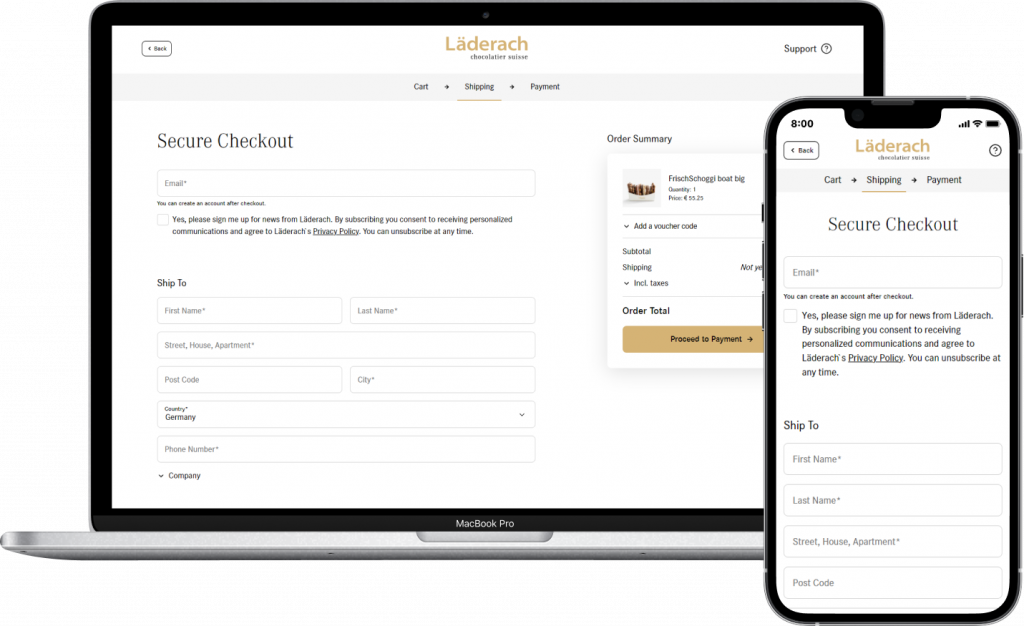
Results and benefits
Having a dedicated eCommerce Manager brings many benefits to a business:
- Continuous CX improvements based on factual data analysis
- Technical support, QA throughout the website, and relevant recommendations for ecosystem enhancements
- Cross-functional collaboration to ensure smooth operations between departments
- A strategic plan in place for executing website-related improvements and seasonal campaigns
- Adaptability to changes regarding technology, consumer behavior, and industry trends.
We observed improvements across KPIs during this management model, underscoring the significant impact of a Dedicated eCommerce Manager. Although an increase in SEO and PPC budget contributed to these results, CX changes were identified as a key driver of success. Most notable KPI improvements:
- +40.4% eCR
- +95.4% purchase revenue
- +77% transactions
- +10.4% average order value
- -20.8% bounce rate
- +34.3% engaged sessions
- +55.2% sessions with add-to-cart
- +61.1% sessions with checkouts
We also observed drop-off rates decrease for Läderach on all shopping funnel steps.
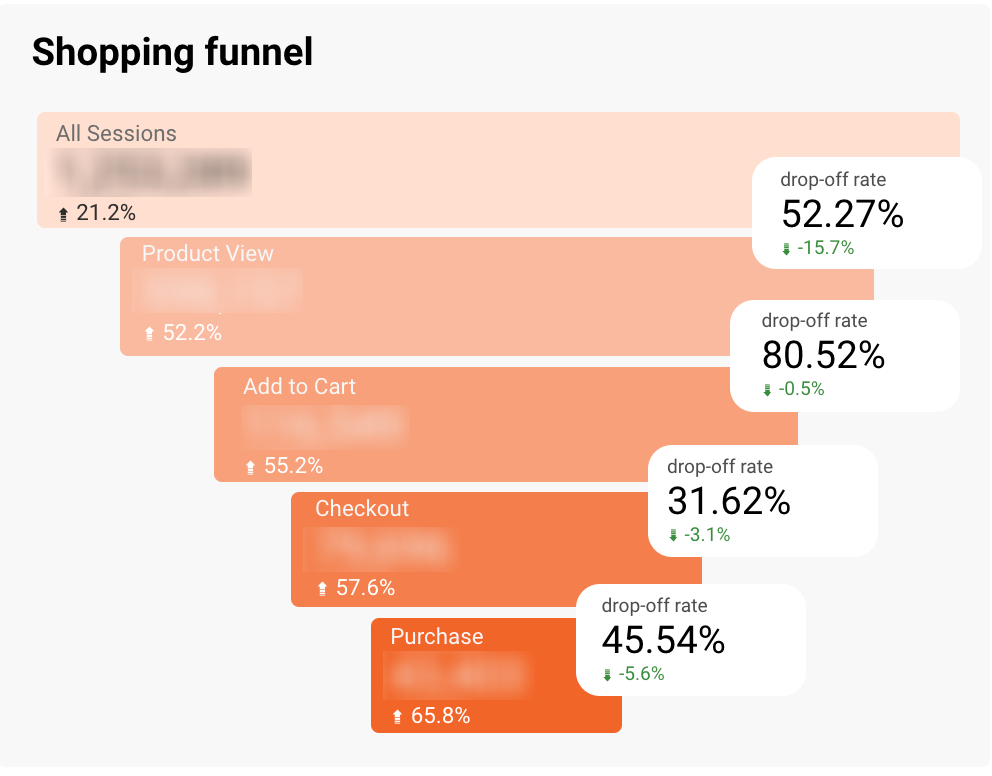
Do you think your store could benefit from an experienced Dedicated eCommerce Manager? Our CX team is here to guide your business to higher conversions. Start with a free website audit, and let’s connect and start building your success story!
The post Case Study: How a Dedicated eCommerce Manager Can Help Your Online Business appeared first on scandiweb.
]]>


